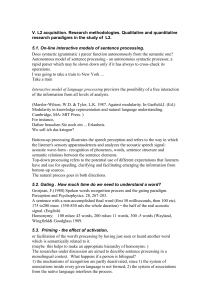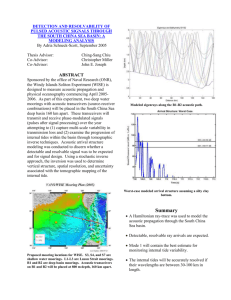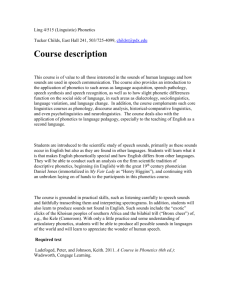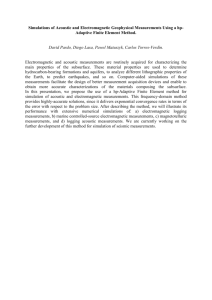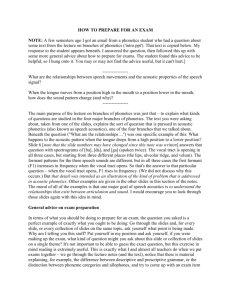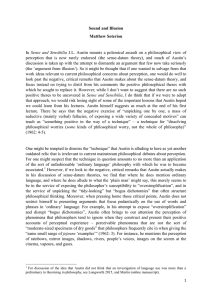Final Project CGSC 633 – Acoustic Phonetics – Spring 2013 1
advertisement
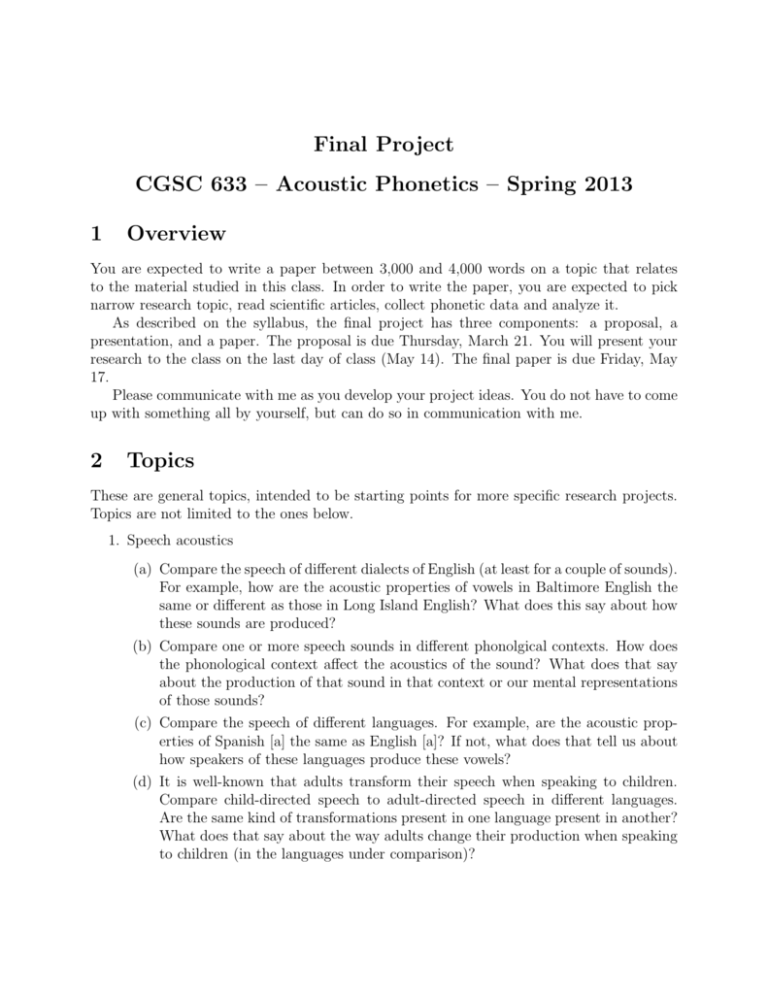
Final Project CGSC 633 – Acoustic Phonetics – Spring 2013 1 Overview You are expected to write a paper between 3,000 and 4,000 words on a topic that relates to the material studied in this class. In order to write the paper, you are expected to pick narrow research topic, read scientific articles, collect phonetic data and analyze it. As described on the syllabus, the final project has three components: a proposal, a presentation, and a paper. The proposal is due Thursday, March 21. You will present your research to the class on the last day of class (May 14). The final paper is due Friday, May 17. Please communicate with me as you develop your project ideas. You do not have to come up with something all by yourself, but can do so in communication with me. 2 Topics These are general topics, intended to be starting points for more specific research projects. Topics are not limited to the ones below. 1. Speech acoustics (a) Compare the speech of different dialects of English (at least for a couple of sounds). For example, how are the acoustic properties of vowels in Baltimore English the same or different as those in Long Island English? What does this say about how these sounds are produced? (b) Compare one or more speech sounds in different phonolgical contexts. How does the phonological context affect the acoustics of the sound? What does that say about the production of that sound in that context or our mental representations of those sounds? (c) Compare the speech of different languages. For example, are the acoustic properties of Spanish [a] the same as English [a]? If not, what does that tell us about how speakers of these languages produce these vowels? (d) It is well-known that adults transform their speech when speaking to children. Compare child-directed speech to adult-directed speech in different languages. Are the same kind of transformations present in one language present in another? What does that say about the way adults change their production when speaking to children (in the languages under comparison)? Acoustic Phonetics Project — Spring 2013 J. Heinz (e) Investigate atypical human speech, such as stuttering, lisping, or other problems with motor coordination or motor planning. What are the acoustic consequences of the lack of motor control? Is the success of various treatments measured through acoustic analysis? If so, how and why? If not, why not? (f) Investigate the articulatory or acoustic characteristics of singing, such as yodelling, throat singing, sopranos, etc. (g) Investigate sound-wave communication of a non-human species, such as (some species of) birds, whales, dolphins, chimpanzees. What are the acoustic characteristics of these sounds? How much sense does source-filter theory make of this given the nonhuman “vocal tracts” of these animals? 2. Perception (a) Attention and perception. It is an incredibly difficult problem to understand how people focus their attention on certain auditory signals, but not others. This has huge implications for speech technology, including the development of hearing aids which are designed to attune to speech. Is auditory attention different from visual attention? What is the neurological basis for auditory attention? (b) How is pitch perceived? Pitch has very clear acoustic definitions, but our perception of pitch, in speech, music, and noise, is much more complicated. (c) Auditory illusions. In the same way our eyes can be fooled by Escher’s ever ascending stairs, our ears can be fooled by Shepherd’s ever ascending scales. What are some auditory illusions and why are our ears fooled by them? (d) Perception of language sounds. How do English speakers perceive aspiration of stops in Nepali? Can they discriminate them from other similar speech sounds? Design an experiment to investigate how such sounds are perceived (if at all). 3. Other phonetic research. Something not clear in the text? Pick a topic in phonetics and do some further research on it. The references in the textbook and in the other texts recommended for the course provide plenty of papers to get started. 3 Experimental research As part of your project, you may have to acquire measurements from tokens of speech from various populations to measure. Here are acceptable ways to do that. 1. Obtain measurements from published sources or publicly available sound files. 2. Design a production experiment. Elicit the speech from the relevant populations, label it, and make measurements using Praat. 2 Acoustic Phonetics Project — Spring 2013 J. Heinz 3. Use Very Large Speech Corpora (VLSP). There is an outstanding amount of speech that is increasingly available either online or in academic warehouses, etc. Additionally, there is an increasing amount of accessible technology that allows one to automatically label and extract measurements from such speech corpora. Get a head start and use this class as an opportunity to learn to use these tools. Here are some things to keep in mind. • Choose your experiment carefully! Don’t try to do much. For example, if you are comparing speech from different dialects of English, choose at most a few speech sounds and keep the contexts constant. • Make sure you motivate this experiment. Why are you doing it? What can you learn from it? In the example above, suppose you find a significant difference in some acoustic property between the “same” speech sound in different dialects. What does this mean in terms of how the two sounds are articulated? • It is acceptable to follow a lab-style format with the appropriate sections (there is some flexibility here, you can add/rename sections as appropriate to your work). Make sure you state your hypothesis and goals in the beginning and describe your methodology thoroughly. 4 Proposal • Requirements: 1. Proposals should be between 250 and 500 words, excluding references. 2. Some references should be included. Acceptable references are from journal articles and books (not websites). • Recommendations: 1. Think of a question your research will answer. 2. Explain why this question is interesting to you and/or why it is important. 3. Explain how you plan to go about answering this question. 5 Presentation • Requirements: 1. Presentations are between 10 and 15 minutes. 2. Presenters should prepare a slide presentation (e.g. PowerPoint). 3 Acoustic Phonetics Project — Spring 2013 6 J. Heinz Paper • Requirements: 1. Papers should be between 3,000 and 4,000 words. 2. Cite all sources and include a list of references at the end of your paper. 3. If you include a graph or figure from another source, indicate that in the caption. 4. The purpose of the paper should be clear. (For example: “This paper shows there are three acoustic characteristics of . . . ”.) 5. Your paper should be well-organized. 6. Your paper should be clear and easy to read. 4



